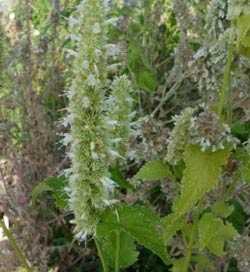Highlander Baldzhuan melliferous plant, which is a perennial abundantly flowering climbing ornamental plant of the buckwheat family. Blooming liana is readily visited by bees.
The honey plant is valuable as a source of supporting bribe. It is known by other names such as “fallopia” or “buckwheat”.
The content of the article
- 1 Distribution and Description
- 1.1 Varieties
- 2 Significance for agriculture
- 3 Agrotechnics
- 4 Honey productivity
Distribution and Description
This fast growing vine is native to Central Asia. It is massively grown by gardeners in Europe, Ukraine and Russia. Grows best in southern areas with mild weather conditions.
The stems of the honey plant grow up to fifteen meters in length. Young thin shoots are green, smooth, and old ones have a grayish color and a coarser, rough surface. In one season, they grow up to five meters in length. Light green leaves are large, long, cordate or oval, pointed.
Small white flowers with a pinkish shade of petals are collected in large branched paniculate pointed inflorescences. Bloom in large quantities in May and bloom profusely until the end of June. It is possible to re-bloom in autumn – in September or October, before the first persistent sub-zero temperatures.
Varieties
The Baldzhun highlander is one of the subspecies of the numerous highlanders of the buckwheat family. In this large genus, scientists count just over 300 species that exist at the moment.
Therefore, they are all divided into several small subspecies: peacaria, bistorta, fallopia and rhineotria.
Among them are distinguished:
- annual plants – for example, bird knotweed or knotweed, which is widely known in folk medicine;
- large perennials and lianas-trees – for example, the snake highlander, called “crayfish necks because of the special shape of the rhizomes;
- aquatic plants – for example, the amphibian mountaineer, which can most often be found in stagnant reservoirs of the middle lane;
- climbing vines – this includes the Baljuan species.
Significance for agriculture
The curly Baljuan species is used by gardeners as a fast-growing and abundantly flowering ornamental plant.
It is mainly used for quick vertical gardening of city walls, fences, balconies or gazebos in personal plots. Liana can be grown in a tub and used for effective decorative decoration of terraces and balconies.
Agrotechnics
The honey plant grows well in partial shade, in sheltered and insulated places. Withstands direct exposure to bright sunlight well.
For planting, it is not necessary to prepare an area with rich soil. Liana does not tolerate an excessive amount of applied fertilizers.
The mountaineer does not survive frost well – his shoots freeze to the level of snow. In spring, it grows rapidly from the root, but with persistent frosts it can die.
Easily grown by seeds and green cuttings.
Large seeds are immediately planted in a permanent place of growth in late autumn. They hatch quickly at temperatures up to 25 degrees Celsius.
It is customary to germinate small seeds for two months, after which the most presentable-looking samples are planted in open ground in the spring with abundant watering. Liana tolerates such a transplant perfectly.
Honey productivity
Abundantly flowering shoots of lianas massively attract bees with their fragrant aroma. The plant is unambiguously a valuable supporting summer and autumn honey plant.
Since the Baljuan species of the mountaineer is grown in small numbers (mainly by gardeners near their homes), it does not form extensive dense thickets.
It is for this reason that bees collect a small amount of nectar from flowering plants, which provides only a supporting seasonal flow. There is no monofloral type of honey on the market.
